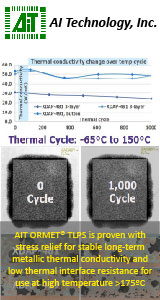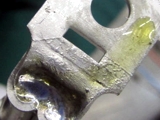|

|
|
| Ask the Experts | ||||||||
|
||||||||
|
July 14, 2025 - Updated February 5, 2014 - Originally Posted Excess Flux Residue After Hand Soldering
Is this amount of excess flux normal? Is there something wrong with our manual soldering operation? K.K. |
||||||||
| Expert Panel Responses | ||||||||
|
The answer is it depends but this appears to be excessive on the contact, but was a different amount of solder wire or larger core used to solder the sample. I would be more concerned is the flux benign or still corrosive (no clean flux requires additional heat to complex the flux to create a benign residue and this looks like it is far from the solder joint heating). The other question to ask if this is insulative do you want it on the contact that is designed to make electrical contact.
President/Senior Technical Consultant Foresite Mr. Munson, President and Founder of Foresite, has extensive electronics industry experience applying Ion Chromatography analytical techniques to a wide spectrum of manufacturing applications.
The picture shows flux residue from soldering using solder wire which is not uncommon. Flux residue will depend on the percentage of flux in the wire. Flux percent by weight will vary from 0.5% to 3% in solder wires and higher percentages will leave more visible flux residue. Less flux in the wire, less flux residues, however you need a good percentage to enable ease of soldering. Usually 1, 2 or 3 % flux is best with 0.5% being more difficult to use by operators. If the residue is from flux that are no-clean in nature the residue will not cause issues normally. Most no-clean solder wires are described as ROL0. No-clean,RA, RMA flux wires have fluxes which are resin based and slightly higher or lower soldering tip temperatures will not impact the volume of visible flux. Resins tend to have high boiling points and do not vaporize with soldering tip temperatures. If temps are too high the resin will darken and burn. This will render it harder to clean off later.
Senior Market Development Engineer Kester Mr. Biocca was a chemist with many years experience in soldering technologies. He presented around the world in matters relating to process optimization and assembly. He was the author of many technical papers delivered globally. Mr. Biocca was a respected mentor in the electronics industry. He passed away in November, 2014.
Flux residue is proportional to the percentage of flux in the wire and the amount of wire fed into the joint.Wire solder that is '2% flux core' is 2% flux core by weight - it's approximately 50% by volume. Therefore, if the joint accepts a lot of solder, then there is going to be more residue. In the image you provided, the terminal looks to hold a lot of solder therefore you could expect more visible residue, but I would not consider it excessive. You could experiment with different manufacturers wire solder products to see if they leave less residue as flux formulation can significantly impact location/appearance/volume of residue.
Director of Product Management AIM Timothy O'Neill is the Director of Product Management for AIM Solder. AIM Solder is a leading global manufacturer of assembly materials for the electronics industry. Mr. O’Neill has 25 years of industry experience is a Certified IPC Specialist.
Mr. O’Neill’s responsibilities include developing product and technical information; he is a technical writer and presenter for industry trade publications and events and has been recognized as a Speaker of Distinction by the SMTA. First, it is assumed that this is a No-Clean flux-cored solder wire. If not, then the residue would have to be removed. If this is a No-Clean flux-cored solder wire there is nothing wrong with your soldering but ways to make it look better. Seeing that the flux-cored solder wire has been heated fully to alloy melting, the flux within has been heated sufficiently to
The IPC-610 standard for workmanship allows flux residue resulting from hand-or machine-soldering as long as the residue has been heated sufficiently to activate it. Any surface that has achieved soldering temperature will certainly render the flux residue activated.
President Colab Engineering A thirty year veteran of electronics assembly with major OEMs including Digital Equipment Corp., Compaq and Hewlett-Packard. President of Colab Engineering, LLC; a consulting agency specializing in electronics manufacturing, root-cause analysis and manufacturing improvement. Holder of six U.S. process patents. Authored several sections and chapters on circuit assembly for industry handbooks. Wrote a treatise on laser soldering for Laser Institute of America's LIA Handbook of Laser Materials Processing. Diverse background includes significant stints and contributions in electrochemistry, photovoltaics, silicon crystal growth and laser processing prior to entering the world of PCAs. Member of SMTA. Member of the Technical Journal Committee of the Surface Mount Technology Association.
The amount of flux does not seem excessive. Soldering this type of terminal requires a fairly high volume of solder, so there will be more residue than fora smaller joint. It may be possible to reduce the amount of residue by purchasing solder wire with a lower flux percentage. Speak with your solder manufacturer about what you are now purchasing, and whether a version with lower flux percentage is offered. If it is, you will need to test it to see whether the reduced flux activity due to less flux is adequate for the application. One other thought; if the flux running down the terminal is of concern,re-orienting the terminal during soldering may avoid this, but of course the residue will still be present.
Process Engineer Astronautics Fritz's career in electronics manufacturing has included diverse engineering roles including PWB fabrication, thick film print & fire, SMT and wave/selective solder process engineering, and electronics materials development and marketing. Fritz's educational background is in mechanical engineering with an emphasis on materials science. Design of Experiments (DoE) techniques have been an area of independent study. Fritz has published over a dozen papers at various industry conferences.
From the photo is appears that your operator is adding flux prior to hand soldering. The flux is too far away from the solder joint so I would check this first. If this is not the case, from the photo it appears that the flux is not activated (as shown) which could mean:
President and CEO PROMATION, Inc. Mr Goldberg has practical experience in production line layout, process flow and cycle rate analysis. He knows how to avoid bottle necks and most related PCB or pallet handling questions.
To determine if the electrical performance will be compromised, a surface insulation resistance test (available in the IPC Test Methods) will show if the residue will be sufficient enough to compromise the finished PCB.Hand soldering temperatures can vary significantly. Soldering tip in relation to board density (which can act as a heat sink), not to mention the human factor, can add up to inconsistent heating ultimately leading to excessive residue.
Director Integrated Ideas & Technologies, Inc. Stephanie Nash is the Director of Technical Services & Marketing for Integrated Ideas & Technologies, Inc., a premier manufacturer of SMT stencils. She has been instrumental in the stencil design and technical support.
In this case, the soldering appears to be on a crimped lug terminal. No flux should be allowed to wick down inside of the wire insulation, and I am also puzzled as to why a crimped connection requires solder? But if a flux must be used, then an RMA tacky flux is preferred as it is the least problematic if some flux does wick inside the wire insulation, but it should be cleaned if at all possible. Typically the best way to clean it is in an ultrasonic cleaner using a 5-7% mix of inert saponifier in hot deionized water (do NOT put IPA or any other flammable solvent in an ultrasonic cleaner; it has a tendency to go BOOM!). Because we are talking about a mechanical subassembly, there is little concern with damage from US cavitation. A tacky flux is much easier to apply and clean in a controlled manner than liquid flux, and will stick around for the whole soldering process, unlike liquid fluxes that typically evaporate or burn off before the soldering is completed but can also wick down into the wire and cause problems later. As to the idea of using a surface insulation resistance test, I am puzzled as to how that is performed on a lug terminal. Would you care to expand on that, Ms. Nash?
Advanced Engineer/Scientist General Dynamics Richard D. Stadem is an advanced engineer/scientist for General Dynamics and is also a consulting engineer for other companies. He has 38 years of engineering experience having worked for Honeywell, ADC, Pemstar (now Benchmark), Analog Technologies, and General Dynamics.
Reader Comment
One of the issues with hand soldering is applying additional flux from a squeeze bottle supposedly to aid in soldering with a cored wire solder. Invariably, the person doing the soldering applies more than is needed, this added flux is not activated by the heat of the iron, and it leaves more residue that must be cleaned. I agree that properly sizing the wire solder for the job is critical and would caution against adding additional flux. If cleaning is required, a proper method using the four critical elements is required: Wet, Scrub, Rinse & Dry. A cleaning solvent dispenser with a scrubbing attachment should be used to control the solvent amount, and drying should be evaporative or with a lint-free wipe.
Russell Claybrook, MicroCare, LLC
|
||||||||
| Submit A Comment | ||||||||
|
Comments are reviewed prior to posting. You must include your full name to have your comments posted. We will not post your email address. |
|
Free Newsletter Subscription
Circuitnet is built for professionals who bear the responsibility of looking ahead, imagining the future, and preparing for it. Insert Your Email Address |
|

|










